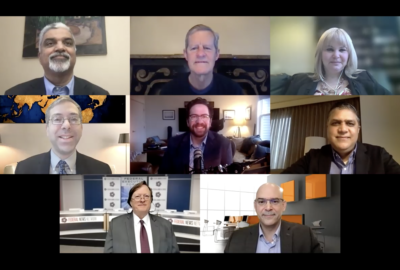

As the size of Treasury's mission has grown exponentially, the never-ending repetitive tasks they tackle have increasingly relied on artificial intelligence and...
The green-eyeshade public servants at the Treasury Department have dealt with large amounts of money for decades. But as the size of their mission has grown exponentially over the years, the never-ending repetitive tasks they tackle have increasingly relied on artificial intelligence and machine learning.
The folks at the Bureau of the Fiscal Service are well aware of how technology leads to faster and more accurate results.
“The Bureau of the Fiscal Service, I would say, is really kind of the operational arm of accounting in the federal government,” said Adam Goldberg, the Treasury Department’s Acting Assistant Commissioner of Financial Innovation and Transformation at the Bureau of Fiscal Service, on Federal Monthly Insights – Repurposing Manpower Through Automation.
The Bureau issues checks to people and businesses, as well as collects funds for federal agencies.
“We finance the government through our auctions and retail security program,” said Goldberg. “And we issue things like the government wide financial statements. They are very practical and pragmatic things to let the government operate on a daily basis.”
Goldberg sees the Bureau generate large volumes of things, which would only be possible through automation.
“Everything today is digital, so all of our capabilities need to align with that,” said Goldberg on Federal Drive with Tom Temin.
As the Bureau constantly strives for ways to be more efficient for taxpayers, that efficiency is made possible with AI, machine learning, and robotic process automation.
“They are very important, because as we are asked to do more things in the government, these are the types of technologies that allow us to do this when we are limited to our existing human capital or we have that downward pressure on human capital, like other agencies do,” said Goldberg.
Goldberg said robotic process automation allows the Treasury Department to automate very structured and routine repetitive tasks
“In the case of artificial intelligence, you’re really dealing with what I would say are unstructured things or activities that require decision making,” said Goldberg. “This might be something like, you get an unstructured sheet of paper where there’s information all over the place, and it doesn’t follow the same terminology. So it doesn’t have like name or address, maybe we use some different terms. So things like artificial intelligence, will help us interpret that through different algorithms that we program”
The Bureau deals with a huge amounts of data, which means mere humans can’t keep track of all it, which, if they did, could let fraud slip through. Fortunately, AI and machine learning play a major role in fraud detection.
“We would be taking millions of records that are coming in and doing some evaluation that would flag which of these records might be susceptible to fraud,” Goldberg said. “This can happen much quicker than a human going through all that data or a human doing some sampling, which often times is a small population that you extrapolate to a universe. These technologies really help us in areas where there’s a large amount of volume to interpret.”
Copyright © 2025 Federal News Network. All rights reserved. This website is not intended for users located within the European Economic Area.
Peter Musurlian is a producer at Federal News Network.
Follow @PMusurlianWFED


